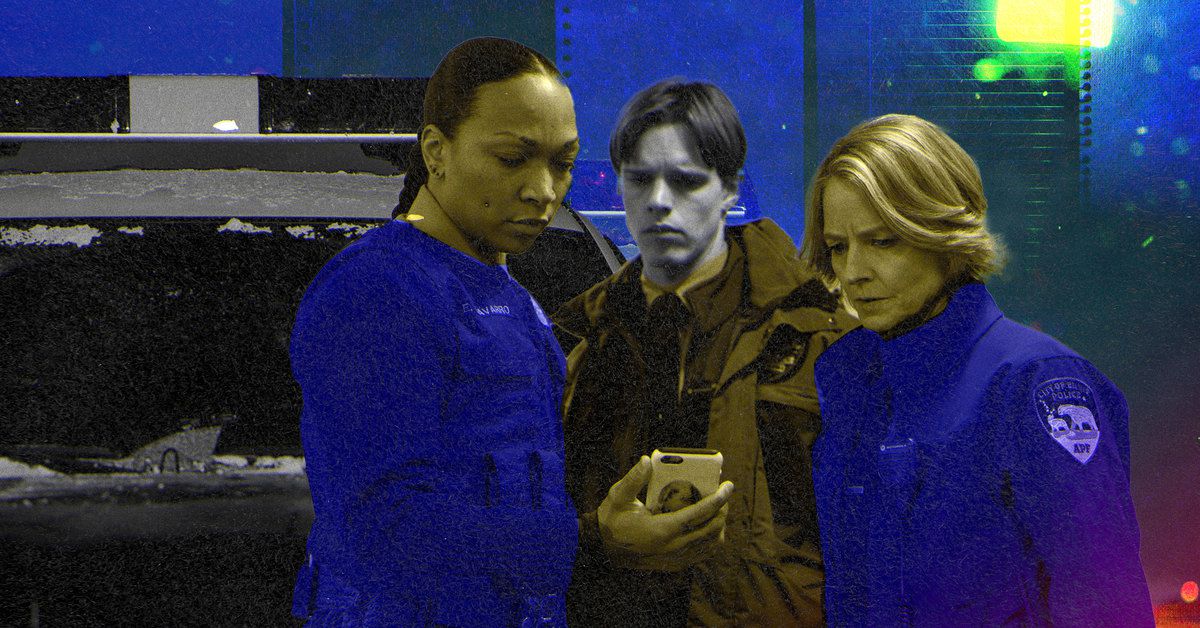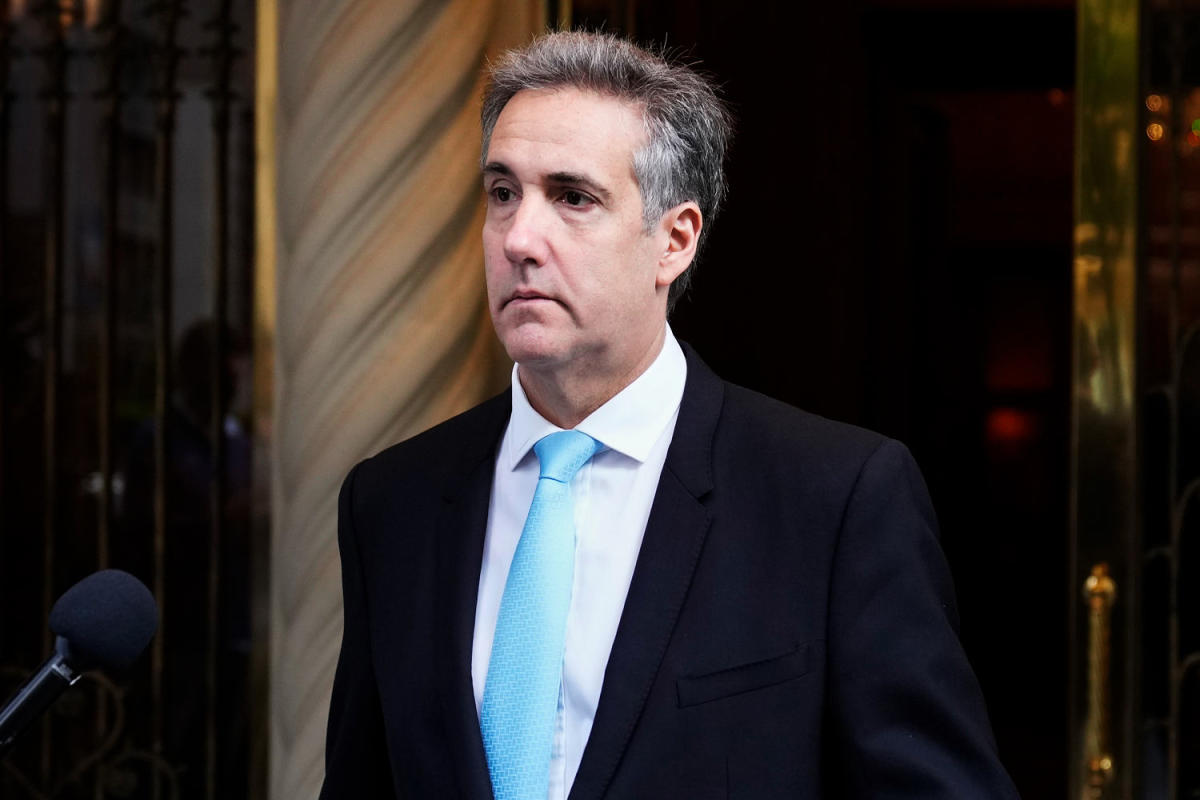After four years away, True Detective returns for a new season with a sinistrous subtitle. We’re in Night Country now, and we’ll be following along each week to try to piece together, with the help of police chief Liz Danvers and detective Evangeline Navarro, who perpetrated those gruesome crimes in Ennis, Alaska. Read along for a breakdown of Episode 3.
Who Done It?
Episode 3 of True Detective: Night Country opens and closes with a woman’s screams, echoing from Ennis’s past into its present. The screams at the start accompany the beginning of life. When Evangeline Navarro, during a flashback from before the Annie Kowtok case, is dispatched to arrest Annie for vandalizing the Silver Sky mine, she finds the wanted woman at an off-the-books birthing center where Annie is assisting a distressed mother in the final stages of labor. After the delivery, Annie pumps air into the silent infant’s lungs, bringing the baby to life. The child greets the world with its own welcome cries.
The screams at the end of the episode accompany the conclusion of life. In Ennis’s present, Annie is long dead, and the town is worse off without her: In the absence of the murdered midwife, the community is mourning a stillbirth. Soon, a second death occurs: Anders Lund, the Tsalal research station scientist who somehow survived encasement in the corpsicle, flatlines following multiple amputations (and one possible demonic possession). After Lund dies, detective Pete Prior meets Navarro and Liz Danvers at the hospital, bearing Annie’s unlocked phone. Huddled in the hallway, the three officers view a video Annie seems to have made moments before her death. “I found it,” she says, in a Blair Witch Project close-up. “It’s here.” Then she drops her phone, obscuring whatever horror she happened upon underneath the ice. Her screams ring out from beyond the grave.
The third installment of Night Country, which covers the fifth and sixth days of darkness, doesn’t do much to advance the investigation of the Tsalal scientists’ deaths: Our detectives get no closer to tracking down lead suspect Raymond Clark, let alone closing the case. But the episode isn’t devoid of major revelations. This week, we solve some mysteries about our prickly protagonists, as Night Country lifts the lid on both Navarro’s family history and the incident that drove her and Danvers apart.
Before we review where our list of suspects stands at the halfway point of the season, let’s recap three crucial conversations, each of which contains some symbolism or subtext.
The first exchange takes place at the police station, after Pete “asks the question” that’s been on all of our minds: What happened between Danvers and Navarro? Liz recounts their last case, which concerned a serial abuser named William Wheeler. As Danvers tells it, Wheeler repeatedly assaulted his 18-year-old girlfriend, who declined to press charges, preventing Danvers and Navarro from putting him away. One day, the detectives were called to Wheeler’s home, only to find the teenager lying dead in front of Wheeler, who, upon the police’s arrival, started smirking and whistling—what else?—“Twist and Shout,” the song that seems to be on heavy rotation on the devil’s radio in Ennis. Liz lies to Pete and tells him Wheeler was dead from a self-inflicted gunshot when she and Navarro arrived. We don’t see how he really died, but the implication is clear: Either Danvers or Navarro killed him, enlisting the other’s assistance in covering up the crime.
Navarro may be the likelier triggerwoman, given her personal history of abuse (at the hands of her father), the way she relished pouring a beer in the gas tank of the unrepentant abuser she arrested in Episode 1, and her unwillingness to let go of the Kowtok case. Then again, Liz isn’t exactly a model of restraint, as we saw in her handling of drunk driver Stacy Chalmers. Perhaps they made a mutual pact to kill Wheeler. However it happened, the execution or the strain of preserving the secret seems to have brought them to a breaking point.
Both the shooting and the misleading description of the way it went down are reminiscent of a memorable scene from Episode 5 of Season 1, when Marty Hart kills Reggie Ledoux after finding the children Ledoux had kidnapped and abused. Rust Cohle, thinking quickly, helps Hart cover up the killing by staging a shoot-out. The detectives stick to their fabricated account when they’re questioned 17 years later, even as we watch the real events play out.
Marty’s murder of Ledoux didn’t stop the serial killing in Louisiana, and Wheeler’s death didn’t end the cycle of abuse in Ennis. Pete listens to Liz’s story with a welt on his cheek from his father’s slap. “Funny, big hockey champion falling on his face on the ice rink,” Danvers says, referring to the bruise. Like Wheeler’s victim, Pete is protecting his abuser. Liz seems to suspect that Pete isn’t telling the truth about the injury, just as Pete seems to suspect that Liz isn’t telling the truth about Wheeler: He later asks Hank what happened between Danvers and Navarro, claiming that Liz won’t tell him. There’s a lot of lying going on in this department—and a lot of lying to oneself, judging by Liz’s belief that no one but Navarro knows about her liaisons with captain Ted Connelly. More like False Detectives, am I right?
The second key conversation takes place at the ice-fishing hut where Navarro seeks out slam piece Eddie Qavvik for intel on former Tsalal equipment engineer Oliver Tagaq. The two sit across from each other, lit from below by the illuminated ice, which casts a glow on their faces not unlike the electric blue in Annie’s (and Julia Navarro’s) hair. Qavvik might be fishing for dinner, but he’s also fishing for information about the woman he’s hooking up with. Eve’s exterior is as frosty as the surface Eddie’s sitting on, but just as he hacks a hole in the ice, he also thaws her hard facade just enough to access her vulnerable interior.
As part of the quid pro quo—but also, perhaps, out of relief to be unburdening herself—Eve reveals that her mother was born in a since-closed gold-mining camp and left Alaska when she was 15. She met Eve’s father in Boston, but Eve’s “dad was bad,” so her mother left her abuser and brought her two daughters back to Alaska. “Alaska girls always come back,” Qavvik says. But one day, Eve’s mother—who, like Julia, heard voices and had episodes in which she was “not OK”—ran out and never came back. Eve’s mother was murdered, and the killer was never caught, which helps explain why Eve takes Annie’s unsolved murder so personally.
Eve’s mother never told her daughter her Iñupiat name, which weighs heavily on Eve as a non-native Alaskan of mixed ancestry. In Inuit cultures, names can carry great weight, linking their bearers to their ancestors and surroundings and reflecting or informing their identities. Hence Eve’s discomfort when Tagaq later asks who she is. “Oh, you forgot, didn’t you?” he says with some combination of pity and scorn. On some level, Eve longs to belong, and by searching for Annie’s killer—a proxy for her mother’s killer—she may hope to take her place among her people more fully, as she does at the birthing center when she takes off her police hat and joins the circle of supportive women.
The third example of multilayered dialogue unfolds between Danvers and Navarro in the latter’s car, on the detectives’ trip back from speaking to Susan, the hairdresser. The two uneasy allies have Muldered and Scullied all season—recall their quips about spirit animals in each of the first two episodes—but they double down on that dynamic here. Liz plays a much saltier Scully: “Don’t give me that voodoo, E.T., choompa loompa cosmic bullshit. … There’s no magic. There’s a real explanation for this.” Eve, meanwhile, wants to believe—or, at least, she has little choice but to believe, given what she’s gone through. “I pray,” she admits, prompting derisive snorts from Liz. Eve doesn’t talk to god, she clarifies; she listens. And someone, or something, certainly seems to have a lot to say these days.
Of course, this conversation mirrors the debate True Detective viewers are having within and among themselves: Is there a rational explanation for all of this, or is something supernatural happening? “Don’t confuse the spirit world with mental health issues,” Rose Aguineau cautioned Eve in the premiere, but director Issa López and Co. are doing their best to entangle the two. Which means that this week’s suspect list must include both corporeal and incorporeal culprits.
1. Raymond Clark
The sole presumed survivor of Tsalal station, and the only scientist to avoid the corpsicle, is still the primary person of interest, but Hank’s manhunt hasn’t turned up any sign of him so far. However, we did learn a few things that seem semi-exculpatory. For one, Annie seems to have been the one who wanted to keep her relationship with Raymond secret, not the other way around. For another, those matching spiral tattoos weren’t Raymond’s idea: Annie got her Carcosa symbol in high school, which caused her recurring dreams of the spiral to subside. And for what it’s worth, Anders doesn’t mention Clark in his moment of terminal lucidity.
Pete’s cousin, Vince the vet, strongly suspects that the scientists didn’t freeze to death; they were seemingly scared to death, like the suicidal caribou in the season’s first scene. Could Clark alone have done something so scary that it simultaneously sent several men into cardiac arrest? (Like, um, reanimated Annie?) Or were the scientists simply infected by some ancient, unearthed microorganism that induced a deadly psychosis?
2. Hank Prior/Silver Sky
Hank probably didn’t do it, but it seems more and more likely that he’s done something (other than shoddy police work). Susan confides that she told Hank about Annie’s relationship with Raymond, which Hank didn’t report. When Eve confronts him, he retorts, “That woman was sleeping with half of Ennis. What do you want me to do, log every dude she was banging in the region?” For one thing, that doesn’t sound like Annie, who appears to have been happy with Raymond. For another … um, yes? Questioning a victim’s romantic partners seems like standard procedure.
Is Hank crooked, incompetent, or both? Eve strongly suspects that Hank is in Silver Sky’s pocket, which would help explain why he took Navarro off the Kowtok case, buried the Clark lead, and kept the Kowtok case files at his house. Consider, also, Hank’s response when Eve tells him they want Raymond alive: “Do we?” If Hank is trying to cover up a crime (or multiple crimes) committed by the mine owners, he’d probably be pleased if Clark didn’t live to tell his tale. Thus, while Hank is whistling Dixie re: his Russian bride, he’s bringing a posse of good ol’ boys whose car horn honks “Dixie.” Maybe Hank hopes his heavily armed recruits will have itchy trigger fingers and kill Clark, turning him into the perfect fall guy. Or maybe he hired them to disrupt the search, which would make it more likely that Clark would escape or perish on the ice. The hillbillies seem to be doing just that, judging by the conveniently timed brawl that breaks out at the hospital.
We know Hank is a bad dad, as shown by his bullying of Pete and his threat to falsely report Liz for sleeping with his son. We know he’s a condescending, insensitive prick who calls Navarro a “girl” and mispronounces her surname. And we know he’s not much of a detective. “Do your fucking job,” an exasperated Liz orders Hank. But if Prior is secretly on Silver Sky’s payroll, this might be what doing his job looks like.
3. Oliver Tagaq
Oliver seems sincere in his surprise about the scientists’ deaths, but he has to have some inkling about the fate that befell them. Why did he leave Tsalal right before Annie died? Why are there no computerized records of his existence or his stint at the research station? Why is he waiting for Danvers and Navarro with a shotgun resting on his lap? (OK, maybe it’s because they were banging on the door.) Why does he ask if Lund, specifically, is dead? And why does he demand that the detectives leave instead of telling them what he knows? Granted, the guy might just like living off the grid, and he might resent cops who poke around on principle. But he wouldn’t serve much purpose in this story unless he’s hiding something.
This may mean nothing, but the camera really lingered on those crampons hanging by Tagaq’s door. Annie was stabbed 32 times with a “sharp, unidentified object” that left “star-shaped wounds.” Those crampons look kinda star-shaped to me.
:no_upscale()/cdn.vox-cdn.com/uploads/chorus_asset/file/25253907/Crampon.png)
Admittedly, right next to the door seems like a logical place to keep crampons, but those spiky cleats were hard not to notice. Then again, wouldn’t the possibility of death by crampon have occurred to Eve during the initial investigation?
4. Sedna
López has acknowledged that the premise of Season 4 is in some respects an inversion (and subversion) of Season 1’s: male victims instead of a female victim, female detectives instead of male detectives, the cold North instead of the sweltering South. Season 1 stopped short of providing proof of paranormal activity. Maybe, then, the best way to turn Season 1 on its head would be to confirm that “cosmic bullshit” is real.
This episode piled up evidence in the “no natural explanation” column. It’s fitting that Liz references E.T. (or, at least, the concept of extraterrestrials) because the sight of something returning Eve’s orange evokes the scene where E.T. throws a baseball back to Elliott (which gave me the creeps as a kid).
Liz hears unexplained whispers. Eve seems to glimpse Liz’s deceased son, who then appears to her after she falls and hits her head on the ice. And then, when Eve is alone with Lund, he eerily rises to a seated position and croaks, “Hello, Evangeline. Your mother says hello. She’s waiting for you.” Then he points at her as Travis pointed toward the corpsicle and croaks for real.
There appear to be only two possible explanations: Either Eve, under stress, is experiencing the same sort of episodes that her mother and sister have, or some supernatural force is responsible—the one that is now awake, according to Clark and various visions. “We woke her,” Anders says while Liz is still in his hospital room. “And now she’s out there, in the ice. She came for us in the dark.”
Who might “she” be? All signs point to Sedna, the Inuit goddess of the sea and ruler of the underworld, a.k.a. Adlivun.
In Episode 1, Pete’s son, Darwin, drew a girl with bloody fingers, which Kayla called a “local legend.” The Inuit creation myth involving Sedna takes various forms, but in most of them, Sedna’s father takes her out to sea, throws her overboard, and then cuts off her fingers as she tries to cling to their kayak. (He, too, sounds like a bad dad.) Those severed fingers morph into sea creatures, which Sedna can control. When humans get on Sedna’s bad side, she can starve them by keeping those creatures away. (Maybe that’s why Qavvik couldn’t catch that fish.)
Check out the Sedna-esque head on the entrance to the meeting Leah attends:
:no_upscale()/cdn.vox-cdn.com/uploads/chorus_asset/file/25253908/Sedna.png)
And listen to what the activist speaker is saying as she enters: “They’re sick. They’re dying. The fish, the whales, the seals, the caribou. What are we gonna eat? We can’t pay for the food in the stores if we starve. Now even our water’s rotten. They’re lying, they’re fucking lying when they say they’re not poisoning us. We want the truth. We want clean water. We want clear skies. We want our animals healthy.”
Perhaps the Tsalal scientists delved too greedily and too deep, and Sedna is what they awoke in the darkness. Maybe the mine’s pollution has angered the god. And maybe she’s punishing the people at fault. Was Anders improbably resurrected just to serve as a mouthpiece for some psychopomp that’s trying to secure Eve’s assistance in setting things right? Was that the “someone” Julia saw coming?
Adlivun, where Sedna imprisons and purifies the spirits of the dead in preparation for their eternal rest, is a frozen wasteland located beneath the land and the sea. “You see that?” Julia asks Eve as they sit on the edge of a twisted boat that’s trapped in the ice. “That’s the water. The sea.” In other words, Sedna’s domain. That subterranean realm calls to mind the refrain of “Sing Sing,” the song by the Bones of J.R. Jones that plays while Danvers and Navarro arrange Clark’s photos in a spiral surrounding them: “Down, down in a hole in the ground / There are ghosts that never can be found.”
I still consider it somewhat unlikely that this season will serve up an unambiguously supernatural resolution. Maybe Darwin—a name associated with science and nature, not the supernatural—was just daydreaming, or maybe someone made of flesh and blood is simply posing as Sedna. (Remember the little girl in Season 1 who described seeing a “green-eared spaghetti monster,” which turned out to be Errol Childress with paint on his ears?) But one way or another, Annie must have found something she shouldn’t have, down, down in a hole in the ground. “I think stuff. Bad stuff,” Julia says. Same. Sail away, Raymond, sail away.
Galaxy-Brained Theory of the Week
You mean, more galaxy-brained than for Oliver to crampon Kowtok to death or a vengeful god to destroy Tsalal’s scientists for having the temerity to tamper with life? I think we’ve covered this category. But I will offer a few more observations:
- What’s with the oranges? Modern Alaskans aren’t as susceptible to scurvy as prospectors and explorers once were, but fresh produce is still scarce in the winter, making fresh fruits and vegetables a delicacy in areas far from Anchorage. “An Alaskan might forgo a latte to pay $5 for a single perfect Sumo mandarin orange,” The New York Times noted in 2018. Oranges would be a big boost to morale on a long, lonely trek across the ice.
- That Liz forces Leah to wipe off her replica tavlugun seems like a textbook case of cultural insensitivity and heavy-handed parenting—and it is. But she reacts so strongly to the sight of Leah’s chin “tattoo” for a reason. When she spots that facial marking, juxtaposed with Leah’s shirt from the community meeting, she sees Annie—and she worries that Ennis won’t let Leah live either. Liz has already lost one child; the thought that her adopted daughter could suffer a fate like Annie’s is more painful than she can communicate. (Liz’s parental impulses are buried, but not lost, as demonstrated by how skillfully she handles story time and making mac and cheese at the hairdresser’s, as well as her attendance at the gathering for the family that lost their baby. Liz may be a misanthrope, but she does have a heart.)
- Another notable Navarro quote from the car conversation: “Don’t you ever get this feeling, like, that sometimes you just wanna just disappear? Just walk out, never stop, just go? Just go.” Liz shifts uncomfortably, suggesting that she has had that feeling—and not just when she gets a great Tinder match.
- While we’re scrutinizing unnerving needle drops, check out the first verse of the song that plays over the closing credits, “Inside” by Chris Avantgarde (featuring Red Rosamond):
If I was you, I’d run
If I was you, I’d hide
If I was you, I’d be afraid
Afraid of what’s inside
Vikram’s Alaska Corner
True Detective: Night Country takes place in the cold fringes of the Last Frontier, otherwise known as Alaska. (Never mind that the season was filmed in Iceland.) The Ringer’s own Vikram Patel is a former resident of the state who still spends his winters there. Each week, we’ll pose a question to Vikram about his second home as we look to learn more about the local geography and culture.
Ben: I have two questions for you, Vikram. As a New Yorker, I’m familiar with the disorienting experience of watching movies and TV shows set in my city that were actually filmed in Toronto, Vancouver, or some other place that’s decidedly not New York. Night Country tries to sell Iceland as Alaska, which mostly passes muster for a non-native like me (though the series strongly reminds me of Iceland-produced series such as Fortitude, Trapped, and A Murder at the End of the World—not to mention more Arctic creepfests like The Terror, The North Water, and, of course, The Thing). Is Ennis ringing true to you? What does the mukluk telegraph say?
Relatedly: Cold climates and isolated locations seem to lend themselves to stories about supernatural horrors and man’s inhumanity to man. Are you happy about how your second state is represented on screen by Night Country and movies such as Insomnia, The Grey, and 30 Days of Night? Or do you wish there were more lighthearted looks at Alaska, along the lines of Northern Exposure, Mystery, Alaska, and The Proposal?
Vikram: Ennis does a pretty good job of mimicking a midsize Alaska Bush community. Specifically, it feels a lot like Nome, a town of about 3,700 people that sits on the Bering Sea. If you’ve heard of Nome, it’s likely because that’s where the Iditarod Trail Sled Dog Race ends. After a thousand freezing miles, mushers and dogs alike pull up to the finish line on Nome’s Front Street, which just so happens to double as the main drag in fictional Ennis.
But those establishing shots (I see you, Board of Trade Saloon) aren’t the only reason the town of Ennis feels like Alaska; Night Country got a lot of the small details right. Producers from the show worked with locals in Nome to ensure Ennis’s accuracy, and it seems to have paid off. I checked in with a few friends who still live in Alaska (thank you, Tara, Emily, Zach, and Barry), and everyone agrees that the overall vibe is right, from the outfits and cars to the police station that is a converted dental office to the stacks of Costco nonperishables (shout-out to those Kirkland tortilla chips).
But not everything is perfect. My friends had a few qualms:
- The ice rink facility is far too big for a town the size of Nome.
- The Arctic Inn, where Captain Connelly stayed in Episode 2, looked like it belonged in a much gentler climate. Bush Alaska doesn’t do a lot of white picket fences.
- But the best nitpick I heard from a friend had nothing to do with a detail about the town of Ennis and more to do with Liz Danvers’s dating preferences. She told me it was unrealistic for Liz to not be interested in the teacher, Adam Bryce, as he would easily be the most eligible bachelor in Alaska. On behalf of all the fellas: Ouch!
Still, the consensus is that this is one of the best takes on an Alaskan Bush community that we’ve ever seen in popular media.
On the topic of the wide range of Alaska depictions—that’s a thinker! I am really enjoying Night Country, but in terms of the violence and supernatural elements, it (thankfully) does not remind me much of my life in Alaska. Northern Exposure offers a reality that is much closer to the small, quirky, where-everybody-knows-your-name Alaska that I know and love.
Part of what makes Alaska so special is the extreme conditions, and it takes a certain kind of person to choose that life. Most of the people I know in Alaska didn’t grow up there; they moved up for a temporary job and then decided to stay. They ultimately chose the adventure, and in the process, they chose each other. You can see some of that self-selection in the DNA of intense dramas like Night Country, but also in gentler fare like Northern Exposure.
You asked if I wished there were more lighthearted looks at Alaska. If I’m being honest, I think I just wish there were more stories set in Alaska overall. I can’t get enough!
Ben: Speaking of people who can’t get enough: This week we learned that Liz’s hookup radius extends well beyond Ennis. We don’t know how far Ennis is from Fairbanks, but for what it’s worth, the trek from Fairbanks to Nome is more than 500 miles. If she’s willing to travel that far for sex between meetups with Ted for cop-on-cop fucky-sucky, no wonder Mr. Bryce hasn’t locked Liz down.
I’d love to get a look at Liz’s Tinder bio. Here’s how I picture it:
:no_upscale()/cdn.vox-cdn.com/uploads/chorus_asset/file/25253909/tinder_TD.jpg)
Iconic True Detective Looks of the Week
Underneath the true crime mysteries at the forefront of each season, True Detective is admirably devoted to capturing the aesthetics that define each of its many eras. With that comes some pretty incredible costume and makeup work, which we’ll be highlighting throughout the season.
:no_upscale()/cdn.vox-cdn.com/uploads/chorus_asset/file/25253910/Leah.png)
Badass.
:no_upscale()/cdn.vox-cdn.com/uploads/chorus_asset/file/25253911/Eddie.png)
When I look at this fit, I’m suddenly seized with a strong urge to ice fish. Qavvik’s gettin’ hygge wit it.
:no_upscale()/cdn.vox-cdn.com/uploads/chorus_asset/file/25253913/Unicorn.png)
Where do I get my daughter one of these?
:no_upscale()/cdn.vox-cdn.com/uploads/chorus_asset/file/25253914/HairdresserWoman.png)
All hail the episode MVP: the woman with highlight foils who waited patiently for Navarro to grill her hairdresser before finishing her appointment.
Finally, while it’s not a look that anyone would want to cultivate, we’ve gotta give a (frostbitten) hand to the makeup and cosmetic artists who defrosted Anders. As the nurse says, “Be prepared—he’s hard to look at.”
:no_upscale()/cdn.vox-cdn.com/uploads/chorus_asset/file/25253915/Anders.png)
Anders resembles Beck Weathers just after his escape from Mount Everest, but unlike Weathers, he won’t recover. Here’s hoping he has a peaceful stay in Adlivun.

Laura Davis is an entertainment aficionado who delves into the glitz and glamour of the entertainment industry. From Hollywood to Broadway, she offers readers an insider’s perspective on the world of movies, music, and pop culture.








/cdn.vox-cdn.com/uploads/chorus_asset/file/24171032/226393_Microsoft_surface_Pro_9_Intel_AKrales_0190.jpg)